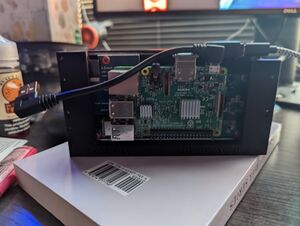Check out my first novel, midnight's simulacra!
Waveshare AMOLED: Difference between revisions
| Line 16: | Line 16: | ||
hdmi_timings=1080 1 26 4 50 1920 1 8 2 6 0 0 0 60 0 135580000 3 | hdmi_timings=1080 1 26 4 50 1920 1 8 2 6 0 0 0 60 0 135580000 3 | ||
</pre> | </pre> | ||
When using the [[Potato|Libre Potato]], the <tt>meson_dw_hdmi</tt> module must be blacklisted, or you'll get a black screen. This can probably be worked around, but I don't yet know how. | |||
==Console rotation== | ==Console rotation== | ||
Revision as of 19:45, 2 June 2022
I am using a 5.5" Waveshare AMOLED capacitive screen in my workstation, together with a Raspberry Pi 3B. They are powered over USB from Molex, and receive data using IP-over-USB together with an internal USB3 header. It's a great little device at a good price point (about $130), though quite fragile.
The Waveshare wiki page for the device is a good place to start. The screen takes anywhere from 250 to 650mA, using more power to display lighter, brighter pixels.
Green LED
When the device is powered up, a green LED will blink if it is not receiving an HDMI signal. The manual only mentions that this can happen due to power supply issues, but that is incorrect (power supply issues can cause this symptom, but it can also simply be due to missing/bad HDMI input).
Raspbian
Add to config.txt:
max_framebuffer_height=1920 config_hdmi_boost=10 hdmi_group=2 hdmi_force_hotplug=1 hdmi_mode=87 hdmi_timings=1080 1 26 4 50 1920 1 8 2 6 0 0 0 60 0 135580000 3
When using the Libre Potato, the meson_dw_hdmi module must be blacklisted, or you'll get a black screen. This can probably be worked around, but I don't yet know how.
Console rotation
Write 1 to /sys/class/graphics/fbcon/rotate. To do it from the kernel, add fbcon=rotate:1 to the kernel command line; in Raspbian, this is done by editing /boot/cmdline.txt. This has no effect on Xorg.
Assembling front pane

- Insert AMOLED into brace by slowly pushing it down
- Insert micro-USB touch input bridge into AMOLED
- Mate Raspberry Pi to AMOLED via touch input bridge
- Insert HDMI bridge into AMOLED and Raspberry Pi
- Insert left-angled micro-USB cable into Raspberry Pi
- Insert right-angled micro-USB connector into AMOLED
- Insert straight micro-USB cable into connector
- Insert Ethernet cable into Raspberry Pi
- Mount with M2.5 screws
- GPIO pin 6 (ground) to LED long leg
- LED long leg to 330Ω resistor
- Resistor to GPIO pin 12